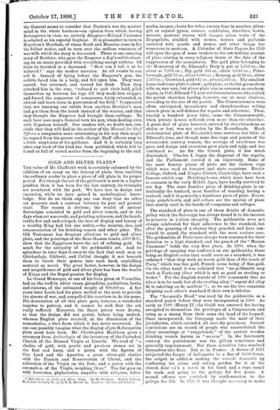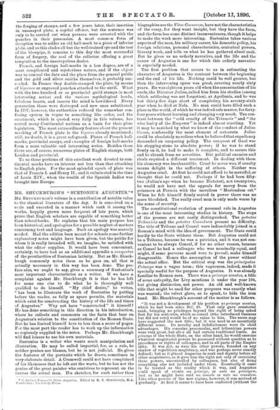GOLD AND SILVER PLATE.°
THE value of Mr. Chaffers's work is certainly enhanced by the addition of an essay on the history of plate, thus enabling the ordinary reader to place a piece of old plate in its proper period. For though the art of the goldsmith is now in a higher position than it has been for the last century, its triumphs are numbered with the past. We have lost in design and execution, while we have gained in metallurgical know- ledge. Nor do we think any one can deny that no other art presents such a contrast between its past and present state. The reason is obvious ; the wealth of ancient Sovereigns consisted in gold and silver vessels, and in the days when art was crude, and painting unknown, and the handi- crafts few and undeveloped, the love of display and luxury of a wealthy King had but one outlet,—the number, size, and ornamentation of his drinking vessels and other plate. The Old Testament has frequent allusions to gold and silver plate, and the paintings of the Beni-Hassan tombs, 2500 B.C., show that the Egyptians knew the art of refining gold. So much for the antiquity of the goldsmith's art. And its splendour in later days it owes to the fact that such men as Ghirlandajo, Ghiberti, and Cellini thought it not beneath them to throw their genius into such hard, unyielding material as metal. The great factor, however, in the design and magnificence of gold and silver plate has been the wealth of Kings and the Royal passion for display.
Le Grand Monarque, at one of his fetes given at Versailles, had on the buffets silver vases, girandoles, jardinieres, bowls, and cisterns, of the estimated weight of 800,000oz. A few years later Louis had his plate melted at the mint to provide the sinews of war, and compelled his courtiers to do the same. His destruction of all this plate gave, however, a wonderful impetus to pottery, and it cannot be said that the art really suffered. Moreover, the finest pieces were drawn, so that the design did not perish, before being melted, whereas English plate received, at the dissolution of the monasteries, a blow from which it has never recovered. No one can possibly imagine what the display of pre-Reformation plate must have been. Mr. Christopher Markham gives a summary from Archwologia of the inventory of the Cathedral Church of the Blessed Virgin at Lincoln. We read of "a chalice of gold, with pearls and precious stones set in the foot and knop, and a paten with the figures of Oar Lord and the Apostles, a great silver-gilt chalice with the Passion and Resurrection of Christ, and the salutation of the Virgin on the foot ; and a paten with the coronation of the Virgin, weighing 74 oz." Tile list goes on with feretories, phylacteries, ampullae with reliquies, taber.
• Hall-Maiks on Gold and Silver Plate. By W. Chaffers. Eiolth Edition. iSdh Intredactory Es-ay by C. A. Idarkh m. London: Reeves and Turner. nacles, images, chests for relics, twenty-four in number, silver- gilt or crystal pyxes, crosses, candelabra, thuribles, bowls, saucers, pastoral staves, with images, silver texts of the Evangelists, studded with stones, morses and garlands enriched with pearls and stones, and other things too numerous to mention. A Calendar of State Papers for 1539. will open the eyes of some readers to the astonishing amount of plate existing in every religious house at the date of the suppression of the monasteries. The gold plate belonging to the Monastery of St. Edmond's Bury is put at 1,553 oz., the silver at 7,976 oz. ; Ely, gold 344 oz., silver 5,040 oz.; Peter- borough, gold 70 oz., silver 5,086 oz. ; Ramsey, gold 16 oz., silver 2 263 oz. ; Crowland, gold 641 oz., silver 2,433 oz. The smallest house had some plate to show; gold plate, as the list given above tells us, was rare, but silver plate was as common as crockery. Again, in 1548, Edward VI. sent out Commissioners who robbed the parish churches leaving, however, one or more chalices,. according to the size of the parish. The Commissioners were often anticipated, incumbents and churchwardens selling church plate in self-defence for repairs and otherwise. Then, exactly a hundred years later, came the Commonwealth, when private houses suffered even more than the churches- A great deal of plate, however, entered by churchwardens as stolen or lost, was not stolen by the Roundheads. Much ecclesiastical plate of Elizabeth's time survives, but little of Edward's time, and though some fine cups and patens of the seventeenth century remain, the average of excellence was poor, and design and execution grew plain and ugly, and has continued so. As for the Crown plate, it has much diminished. Charles I. began the dispersal of the regalia, and the Parliament carried it on vigorously. Some of the most famous pieces of plate are the various cups which were used at banquet and state occasions. Exeter College, Oxford, and Corpus Christi, Cambridge, have each a famous ostrich cup. Drinking-horns, which must have been so common in the early Middle Ages, have hardly survived to our day. The most familiar piece of drinking-plate is un- doubtedly the tankard, most families of standing having a tankard, and it is generally a handsome piece of plate. Ewers, large punch-bowls, and salt-cellars are the species of plate that mostly exist in the hands of companies and colleges.
The standard of plate is one of those details of domestic policy which the Sovereign has always found it to his interest to preserve in jealous integrity. The goldsmiths were not always celebrated for their adherence to the standard, but after the granting of a charter they guarded, and have con- tinued to guard, the standard with the most zealous care. The goldsmiths of Paris have always been renowned for their devotion to a high standard, and the punch of the " Maison. Commune" holds the very first place. In 1300, when the privilege of assaying was conferred on our goldsmiths, there being no English coins that could serve as a etandard, it was ordained "that they work no worse gold than of the touch of Paris," which was fine gold, French coins being of fine gold_ On the other hand, it was ordained that "no goldsmith may work at Paris any silver which is not as good as sterling or better." For the English statute of 1300 commands that no silver is to be made but of the sterling alloy (" argent del alloy de le esterling on de meilleur ") ; so we see the two countries. adopting each other's standard if their own is inferior.
The "Leopard's Head" was used by the goldsmiths as ta standard punch before they were incorporated in 1300. As early as 1180 (Henry II.) the Guild was amerced for having arrogated to themselves the privileges of a Corporation, and using as a stamp from their arms the head of the leopard. Onceincorporated, the Company made the most of their jurisdiction, which extended all over the provinces. Several convictions are on record of people who counterfeited the silver mountings or " cuppebonds " of the ancient wooden drinking vessels known as " mazers." In the fourteenth century the punishment was the pillory sometimes and generally imprisonment. But these seventies later resolved themselves into fines. Not so in France. A decree of 1611 subjected the forger of hall-marks to a fine of 3.000 Hares, the culprit in addition making the amends honorable by confessing his crime and asking pardon for it at the church door eih a torch in his hand and a rope round. his neck, and going to the galleys for five years. A. second offence was punished by condemnation to the galleys for life. In 1724 it was thought necessary to make the forging of stamps, and a few years later, their insertion in unassayed plate, a capital offence, but the sentence was only to be carried out when persons were arrested with the punches in their possession. A most common form of deception was to solder an old hall-mark to a piece of inferior plate, and as this eludes all but the well-trained eye and the test of the blowpipe, it remains to this day the most successful form of forgery, the zeal of the collector offering a great temptation to the unscrupulous dealer.
French, and foreign hall-marks in a less degree, are of a most complicated and mysterious nature, and if the object was to conceal the date and the place from the general public and the gold and silver smiths themselves, it probably suc- ceeded. In France they double-stamped the plate, by means of bigamies or engraved punches attached to the anvil. What with the two hundred or so provincial guild stamps (a most interesting series) and the various mythological heads, fabulous beasts, and insects the mind is bewildered. Every generation these were destroyed and new ones substituted. In 1797, however, the authorities reduced the somewhat con- fusing system in vogue to something like order, and the enactment, which is quoted very fully in this volume, has served many Continental nations as a basis for their plate legislation. The most extraordinary feature about the present marking of French plate is the bigorne already mentioned ; still, no doubt, it is a great safeguard. Plates of French hall- marks, provincial assays, and examples of foreign ball-marks form a most valuable and interesting series. Besides these there are, of course, numerous plates of English stamps, both London and provincial.
To us those portions of this excellent work devoted to con- tinental marks have an interest not less than that attaching to English plate. For the most splendid epoch of plate was that of Francis I. and Henry II., and it culminated in the time of Louis XIV., when the wealth of the Spanish Indies was brought into Europe.







































 Previous page
Previous page